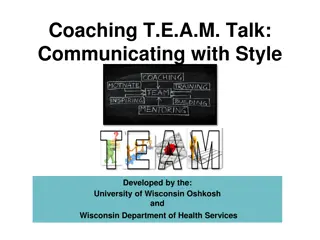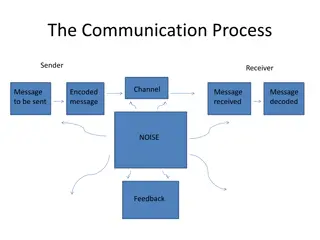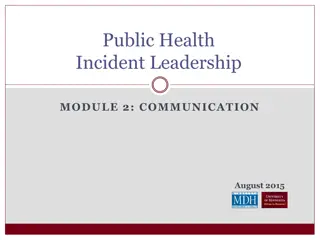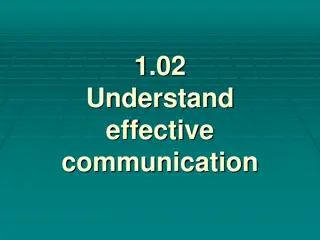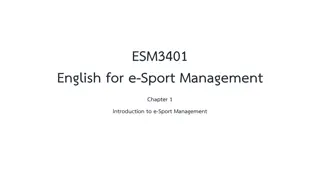Mastering Effective Communication Skills in Daily Life
Enhance your communication skills with insights from Unit 5 Communication. Learn about different types of communication, speaking skills, effective communication strategies, assertiveness, and more. Understand the nuances of verbal, nonverbal, and paralanguage communication to convey your message clearly. Discover the differences between aggressive, passive, passive-aggressive, and assertive communication styles. Strengthen your ability to express yourself, listen actively, and build positive relationships through effective communication techniques.
Download Presentation

Please find below an Image/Link to download the presentation.
The content on the website is provided AS IS for your information and personal use only. It may not be sold, licensed, or shared on other websites without obtaining consent from the author.If you encounter any issues during the download, it is possible that the publisher has removed the file from their server.
You are allowed to download the files provided on this website for personal or commercial use, subject to the condition that they are used lawfully. All files are the property of their respective owners.
The content on the website is provided AS IS for your information and personal use only. It may not be sold, licensed, or shared on other websites without obtaining consent from the author.
E N D
Presentation Transcript
+ Unit 5 Communication Part 1
+Joke of the day What has four wheels and flies? A garbage truck.
+Write down 3 interesting thoughts from video
+Types of Communication Verbal Speaking Listening Nonverbal Paralanguage (tone, pitch) Signs or Symbols Body Language It is not sufficient to know what one ought to say, but one must know how to say it. - Aristotle
+Speaking Skills Clear Must ask for what you want It is not what you say but how you say it. Ex: My teacher asked me to stay after school today. Specific Do you want a listening ear or suggestions? Quick or Slow Underlying emotions (anger, fear, happiness, nervousness, sadness)
+Effective Communication Skills I statements ( I think , I want ) Expressing opinions ( I believe ) Saying No firmly but respectfully Asking for what you want Initiating conversations Expressing positive feelings Expressing appreciation Stating your strengths and abilities ( I can )
+Walk it out On a sticky note write down the definition of the words below and place them on the correct wall What is aggressive communication? (row 1-3) What is passive communication? (row 4-6) What is passive-aggressive communication? (row 6-8) What is assertive communication? (row 8 and on)
+Aggressive and Passive Aggressive Communication expressing needs and desires that does not take into account the feelings of others Passive Communication fail at expressing their opinions, needs or feelings Speak softly Viewed as harsh Apologize often Characteristics sarcasm a harsh tone of voice condescending statements like Example: I don t care where we go. Example: "How could you think that was a good idea?"
+Passive-Aggressive Communication Appear passive on the surface Mutter on their breath Are really acting out anger in a subtle, indirect, or behind-the- scenes way. use facial expressions that don't match how they feel Use sarcasm They feel incapable of dealing directly with the object of their resentments. Deny there is a problem Appear cooperative while purposely doing things to annoy and disrupt They express their anger by subtly undermining the object (real or imagined) of their resentments. Use subtle sabotage to get even
+Assertive Communication Being assertive means being able to stand up for your own or other people s rights calm positive Assertive individuals are able to get their point across without upsetting others, or becoming upset
+Essential Question Name one way to be an effective communicator I statements ( I think , I want ) Expressing opinions ( I believe ) Saying No firmly but respectfully Asking for what you want Initiating conversations Expressing positive feelings Expressing appreciation Stating your strengths and abilities ( I can )
+Practice Makes Perfect Use the worksheet provided to practice how to be assertive
+Joke of the day Which word in the dictionary is spelled incorrectly? Incorrectly
+Think-Pair-Share Are you a good listener, why or why not?
+Listening Skills Receiving the message is just as important as being able to relay the message Active Listening Paraphrasing Feeling Feedback All important skills for listening
+Are you a good listener Face the speaker-Eye contact Try and understand how the speaker is feeling Verbal and nonverbal signs you are listening Don t allow personal biases to affect what you are hearing Pay close attention to what speaker is saying (notice body language) Offer suggestions rather than advice. Ask questions to clarify Give appropriate feedback Empathy 101 Compliment the speaker
+Think-Pair-Share Can you think of someone in your life that is not a good listener? Example why
+Poor Listening Skills Spacing Out: Ignore the person talking to you. Pretend to listen: Pretend to listen, but you are not actually listening. Selective Listening: Only listening to some parts of the conversation Word Listening: not reading between the lines Self-Centered Listening: Listening only so you can speak next.
+ Relationships Unit 5 Communication: Part 2
+Relationship? With the person next to you, try to define the term, relationship
+Relationships A relationship is a connection, association, or involvement with another person or group of people. Relationships are based on commonly accepted values: Respect Honesty Equity Consideration Commitment WHAT DO I MEAN BY THESE VALUES? Let s do an activity to brainstorm.
+ We start forming relationships as soon as we are born, with parents, siblings, and family. At school and in our neighbourhood, we also form friendships with people. As we get older, we form new relationships: Teacher-student Employer-employee Romantic relationships It is important for us to have healthy relationships because they result in many mental and emotional, social, and physical benefits.
+Brainstorm What are characteristics you want in a healthy relationship from friend or boyfriend/girlfriend?
+Homework Complete the relationship chart for homework.
+Joke of the Day You can't keep this until you have be given it. A promise.
+Build A Healthy Relationship Use the blocks to build a healthy relationship Each Block is labeled Respect Consent Faith/Monogamy Protect Self-Respect Boundaries Honesty Put what you believe is the most important characteristic on top
+ Let s compare characteristics of healthy relationships and characteristics of an unhealthy relationships. Healthy Relationships Unhealthy Relationships
Healthy Relationships Unhealthy Relationships + Happiness Trust Love Affection Equality Mutual respect Friendship Laughter Common interests Support Fair arguments Acceptance Comfort Good communication Kindness Strong self-esteem Humour Fun You can be yourself! No fear of each other Honesty Independence No trust Jealousy Abuse (emotional, physical, sexual) Inequity No respect Lack of understanding Unfair arguments Blaming Power issues (controlling) Other person tries to change you Coercion Manipulation Poor communication Low self-esteem No fun Feel like you can t be yourself Fear Lies Not independent people
+Think-Pair-Share With your row, brainstorm some benefits you get from having a healthy relationship.
+Benefits of a healthy relationship Love Companionship Safety Shared interests Affection Sharing hopes, dreams, problems Someone is there for you Shared culture or religion Someone to have fun with
+Part of having a healthy relationship is also being able to effectively communicate to one another. Brainstorm ways you can effectively communicate to someone and ineffectively communicate to someone.
+Brainstorming Effectively Ineffectively
+Supporting Each Other Ways to offer peer support: Lead by example Be a good listener. Use I statements. Offer encouragement and praise Accept. Don t judge. Help with jobs and tasks
+Boundaries: Help separates healthy relationship from unhealthy relationships Walk Towards Me *Notice the distance* In pairs (decide who is A & B ) How did you decide it was time to stay stop? A lines up against one wall B go to opposite side of room When I say go A s will walk towards B s B s will put your hand up and say stop when your partner has gotten close enough and you would feel uncomfortable if they moved closer. Were you surprised at how different people s boundaries are?
+Healthy Boundaries Healthy boundaries SHOULD NOT restrict your ability to: Creating boundaries is a good way to keep your relationship healthy and secure. Go out with your friends without your partner 1. Boundaries are not meant to make you feel trapped or like you re walking on eggshells . Participate in activities and hobbies you like. 2. Creating boundaries is not a sign of secrecy or distrust it s an expression of what makes you feel comfortable and what you would like or not like to happen within the relationship. Not have to share passwords to your email, social media accounts or phone. 3. Respect each other s individual likes and needs 4.
+Refusal Skills Fogging Statements Use humor or tacit to maintain control over situation Clear NO messages Must say NO Body language supports message- serious expression, cross-arms Tone of voice Keep it simple- Don t need to explain Ex: I love you too, but no, I don t want to have sex. Alternative Actions Offer something else to do. Delaying Statements Pretend not to hear what was said Change the subject I ll need to think about that
+Repeat The most difficult thing about social pressure Person rarely quits after the first refusal Just say no-Don t need an excuse What don t you understand about the Word No?
+Unhealthy Relationships Watch the Video and write down 3 interesting thoughts about the video.
+Warning Signs of Abuse Checking your cell phone or email without permission Making false accusations Mood swings Constantly putting you down Physically hurting you in any way Extreme jealousy or insecurity Explosive temper Possessiveness Isolating you from your family or friends Telling you what to do
+Types of Abuse Emotional/Verbal Abuse Non physical behaviors such as: Threats Insults Constant monitoring or checking in Excessive texting Humiliation Intimidation Isolation
+Types of Abuse Stalking being repeatedly watched, followed or harassed Financial Abuse using money or access to accounts to exert power and control over a partner Physical Abuse Any intentional use of physical force with the intent to cause fear or injury like: Hitting Shoving Biting Strangling Kicking Using a weapon
+Types of Abuse Sexual Abuse any action that impacts a person s ability to control their sexual activity or the circumstances in which sexual activity occurs, including restricting access to birth control or condoms Digital Abuse the use of technology such as texting and social networking to bully, harass, stalk or intimidate a partner. Often this behavior is a form of verbal or emotional abuse perpetrated through technology.
+Facts Nearly 1.5 million high school students nationwide experience physical abuse from a dating partner in a single year. 1 in 3 adolescents in the U.S. is a victim of physical, sexual, emotional or verbal abuse from a dating partner. 1 in 10 high school students has been purposefully hit, slapped, or physically hurt by a boyfriend or girlfriend. 25% of teen dating victims say they have been isolated from family and friends.
+Seek Help When you are unhappy in a relationship, but cannot decide if you should accept your unhappiness, try to improve the relationship, or end the relationship. When you have decided to leave a relationship, but find yourself still in the relationship. When you think you are staying in the relationship for the wrong reasons, such as fear of being alone or guilt. If you have a history of staying in unhealthy relationships.
+Sexual Assault and Rape Sexual assault is unwanted sexual contact that stops short of rape or attempted rape. This includes sexual touching and fondling. Rape is forced sexual intercourse, including vaginal, anal, or oral penetration. Penetration may be by a body part or an object.
+Was it Rape? Are the participants old enough to consent? Each state sets an age of consent, which is the minimum age someone must be to have sex. People below this age are considered children and cannot legally agree to have sex In other words, even if the child or teenager says yes, the law says no. The age of consent in New York is 17. Do both people have the capacity to consent? States also define who has the mental and legal capacity to consent. People with disabilities, elderly people drugged unconscious . Did both participants agree to take part? Did someone use physical force to make you have sexual contact with him/her? Has someone threatened you to make you have intercourse with them? If so, it is rape.
+Reduce Your Risk While you can never completely protect yourself from sexual assault, there are some things you can do to help reduce your risk of being assaulted. Try not to load yourself down Make sure your cell phone is with you and charged and that you have cab money. Don't allow yourself to be isolated with someone you don t trust or someone you don t know. Be aware of your surroundings.. Try to avoid isolated areas. It is more difficult to get help if no one is around. Avoid putting music headphones in both ears so that you can be more aware of your surroundings, especially if you are walking alone. Walk with purpose. Trust your instincts. If a situation or location feels unsafe or uncomfortable, it probably isn t the best place to be.
+Reduce Your Risk in Social Situations When you go to a social gathering, go with a group of friends. Arrive together, check in with each other throughout the evening, and leave together. Don't accept drinks from people you don't know or trust. At parties, don t drink from the punch bowls or other large, common open containers. Trust your instincts. If you feel unsafe in any situation, go with your gut. If you see something suspicious, contact law enforcement immediately Watch out for your friends, and vice versa. If you suspect you or a friend has been drugged, contact law enforcement immediately Be explicit with doctors so they can give you the correct tests (you will need a urine test and possibly others). Don't leave your drink unattended
+Where to Get Help National Teen Helplines: 800-273-8255 800-784-2433 800-621-4000 Planned Parenthood 516-750-2500 Guidance Counselor Trusted Adulted











